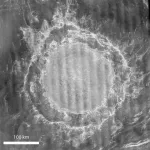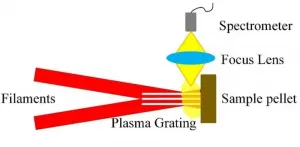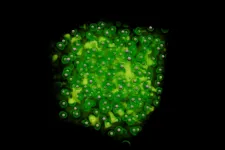Scientists find key function of molecule in cells crucial for regulating immunity
UNC School of Medicine scientists co-led by Jenny Ting, Ph.D., and Yisong Wan, Ph.D., uncovered a new molecular pathway important for the regulation of the adaptive immune system and the mitigation of autoimmune disease
2021-01-28
(Press-News.org) CHAPEL HILL, NC - Many molecules in our bodies help our immune system keep us healthy without overreacting so much that our immune cells cause problems, such as autoimmune diseases. One molecule, called AIM2, is part of our innate immunity - a defense system established since birth - to fight pathogens and keep us healthy. But little was known about AIM2's contribution to T cell adaptive immunity - defenses developed in response to particular pathogens and health problems we develop over the course of our lives.
Now, UNC School of Medicine scientists led by Jenny Ting, PhD, the William Kenan Distinguished Professor of Genetics, and Yisong Wan, PhD, professor of microbiology and immunology, discovered that AIM2 is important for the proper function of regulatory T cells, or Treg cells, and plays a key role in mitigating autoimmune disease. Treg cells are a seminal population of adaptive immune cells that prevents an overzealous immune response, such as those that occurs in autoimmune diseases.
Published in Nature, the research shows that AIM2 is actually expressed at a much higher level in Treg cells of the adaptive immune system than in innate immune cells.
"Our study unveils an unexpected and previously unappreciated role for AIM2 in Treg cells in adaptive immunity, which is independent of AIM2's classic function in the innate immunity," said Ting, co-senior author of the study, member of the UNC Lineberger Comprehensive Cancer Center, and director of the Center for Translational Immunology.
Wan, co-senior author and member of the UNC Lineberger Comprehensive Cancer Center, added, "Because Treg cells are well-known players in a broad range of diseases including autoimmunity, inflammation, and cancers, our findings will help us identify new molecular targets and develop new therapeutic strategies to test against debilitating and fatal diseases."
Normal immune responses are carried out by both innate immunity and adaptive immunity to fight pathogens and maintain biological stability. But these responses need to be regulated so they do not escalate and cause a whole host of different health problems aside from what the pathogen originally caused. Distinct cell types and molecules play discrete roles in the down-regulation of innate immunity and adaptive immunity. This work shows that AIM2, in Treg cells, is one of them. Treg cells dampen over-exuberant immune responses, and so they are critical for the check-and-balance of the immunity system.
Impaired function of Treg cells often perturbs immune system stability and can trigger autoimmune and inflammatory diseases.
In lab experiments led by first author Wei-Chun Chou, PhD, research associate in the Ting Lab, the UNC scientists found that AIM2 was expressed at a much higher level in Treg cells than in innate immune cells, in both mice and humans.
"This suggests a big role for AIM2 in Treg cells," Chou said. "We found that AIM2 is important to maintain the normal function of Treg cells, which could not effectively protect mice from developing autoimmune encephalomyelitis and inflammatory colitis without AIM2."
Those two conditions are models of the human diseases multiple sclerosis and colitis.
"We conducted further molecular and biochemical analysis to reveal a new, cellular signaling pathway of protein molecules in Treg cells - called the AIM2-RACK1-PP2A-AKT pathway - which regulates the metabolism and function of Treg cells to mitigate autoimmune disease."
INFORMATION:
Co-first author Zengli Guo, PhD, a research associate at the UNC Lineberer Comprehensive Cancer Center and in the UNC Department of Microbiology and Immunology, added, "Essentially, AIM2 restrains AKT phosphorylation, an important biological process but one that needs to be regulated."
As a result of these studies, these investigators hope to modulate the expression or function of molecules in the AIM2 signaling pathway in human Treg cells to eventually affect the outcome of diseases such as cancer or autoimmune disorders.
Other authors are: Xian Chen, Maureen Su, Song Zhang, Leslie Freeman, Meng Deng, W. June Brickey, Stephanie Montgomery, Yan Wang, Elena Eampanelli, Sara Gibson, Zianming Tan, Ling Xie, Kaixin Liang, Ge Zhang, Liang Chen, and Hao Guo.
Funding for this research: National Institutes of Health, the National Multiple Sclerosis Society, UNC Lineberger, and a Yang Family Biomedical Scholar Award to Yisong Wan.
ELSE PRESS RELEASES FROM THIS DATE:
2021-01-28
DURHAM, N.C. -- When their manhood is threatened, some men respond aggressively, but not all. New research from Duke University suggests who may be most triggered by such threats - younger men whose sense of masculinity depends heavily on other people's opinions.
"Our results suggest that the more social pressure a man feels to be masculine, the more aggressive he may be," said Adam Stanaland, a Ph.D. candidate in psychology and public policy at Duke and the study's lead author.
"When those men feel they are not living up to strict gender norms, they may feel the need to act aggressively to prove their manhood -- to 'be a man'."
The pair of studies considered 195 undergraduate students and a random pool of 391 men ages 18 to 56.
Study participants were asked a series ...
2021-01-28
Tiny molecular forces at the surface of water droplets can play a big role in laser output emissions. As the most fundamental matrix of life, water drives numerous essential biological activities, through interactions with biomolecules and organisms. Studying the mechanical effects of water-involved interactions contributes to the understanding of biochemical processes. According to Yu-Cheng Chen, professor of electronic engineering at Nanyang Technological University (NTU), "As water interacts with a surface, the hydrophobicity at the bio-interface mainly determines the mechanical equilibrium ...
2021-01-28
PROVIDENCE, R.I. [Brown University] -- At some point between 300 million and 1 billion years ago, a large cosmic object smashed into the planet Venus, leaving a crater more than 170 miles in diameter. A team of Brown University researchers has used that ancient impact scar to explore the possibility that Venus once had Earth-like plate tectonics.
For a study published in Nature Astronomy, the researchers used computer models to recreate the impact that carved out Mead crater, Venus's largest impact basin. Mead is surrounded by two clifflike faults -- rocky ripples frozen in time after the basin-forming impact. The models showed that for those rings to be where they ...
2021-01-28
BOSTON-Boston Medical Center has released a study that shows post overdose outreach programs in Massachusetts have expanded across the state, as 44 percent of municipalities reported having such programs available - a majority established since 2015 - to reduce risks for those who survive an overdose. The results are published online in the February 2021 issue of Drug and Alcohol Dependence.
These post-overdose outreach programs leverage collaborations between public health overdose prevention practitioners and public safety organizations (police, fire, EMS) to engage overdose survivors and/or their social networks (family, friends, and acquaintances) at their home one to three days after an overdose. ...
2021-01-28
Laser-induced breakdown spectroscopy (LIBS) is a rapid chemical analysis tool. A powerful laser pulse is focused on a sample to create a microplasma. The elemental or molecular emission spectra from that microplasma can be used to determine the elemental composition of the sample.
Compared with more traditional technology, like atomic absorption spectroscopy and inductively coupled plasma optical emission spectroscopy (ICP-OES), LIBS has some unique advantages: no sample pretreatment, simultaneous multi-element detection, and real-time noncontact measurements. These advantages make it suitable for practical analysis of solids, gases, and liquids.
Traditional LIBS and extensions
Traditional ...
2021-01-28
The study of warm dense matter helps us understand what is going on inside giant planets, brown dwarfs, and neutron stars. However, this state of matter, which exhibits properties of both solids and plasmas, does not occur naturally on Earth. It can be produced artificially in the lab using large X-ray experiments, albeit only at a small scale and for short periods of time. Theoretical and numerical models are essential to evaluate these experiments, which are impossible to interpret without formulas, algorithms, and simulations. Scientists at the Center for Advanced Systems Understanding (CASUS) at the Helmholtz-Zentrum Dresden-Rossendorf (HZDR) have now developed a method to evaluate such ...
2021-01-28
With a powerful enough light, you can see things that people once thought would be impossible. Large-scale light source facilities generate that powerful light, and scientists use it to create more durable materials, build more efficient batteries and computers, and learn more about the natural world.
When it comes to building these massive facilities, space is money. If you can get higher-energy beams of light out of smaller devices, you can save millions on construction costs. Add to that the chance to significantly improve the capabilities of existing light sources, and you have the motivation behind a project that has brought scientists at three U.S. Department of Energy national laboratories together.
This team has just achieved an important milestone ...
2021-01-28
Attempts to identify the genetic causes of neuropsychiatric diseases such as post-traumatic stress disorder (PTSD) through large-scale genome-wide analyses have yielded thousands of potential links. The challenge is further complicated by the wide range of symptoms exhibited by those who have PTSD. For instance, does extreme arousal, anger, or irritation experienced by some have the same genetic basis as the tendency to re-experience traumatic events, another symptom of the disorder?
A new study led by researchers at Yale and the University of California-San Diego (UCSD) provides answers to some of these questions and uncovers intriguing genetic similarities between PTSD and other mental health disorders such as anxiety, bipolar disorder, and schizophrenia. ...
2021-01-28
Washington, DC - January 28, 2021 - Self swabs and caregiver swabs are effective at detecting multiple pathogens and are just as accurate as those taken by healthcare workers, according to a team of Australian researchers. The research appears in the Journal of Clinical Microbiology, a publication of the American Society for Microbiology.
"Across the range of pathogens and swab types, there was high agreement between results from self- or caregiver swabs and those performed by a healthcare worker, even when different sites were swabbed (e.g. nasopharyngeal vs. nasal)," said principal investigator Joshua Osowicki, BMedSci, MBBS, FRACP, a Pediatric Infectious Diseases physician in the Murdoch Children's Research Institute's ...
2021-01-28
Despite long-standing ideas about the importance of thumb evolution in tool use and development, questions remain about exactly when human-like manual dexterity and efficient thumb use arose--and which hominin species was the first to have this ability. Now, researchers who've analyzed the biomechanics and efficiency of the thumb across different fossil human species using virtual muscle modeling have new insight into when these abilities first arose and what they've meant for the development of more complex human culture. The findings, appearing January 28 in the journal Current Biology, suggest that a fundamental aspect of human thumb opposition first appeared approximately 2 million years ago and was not found ...
LAST 30 PRESS RELEASES:
[Press-News.org] Scientists find key function of molecule in cells crucial for regulating immunity
UNC School of Medicine scientists co-led by Jenny Ting, Ph.D., and Yisong Wan, Ph.D., uncovered a new molecular pathway important for the regulation of the adaptive immune system and the mitigation of autoimmune disease




